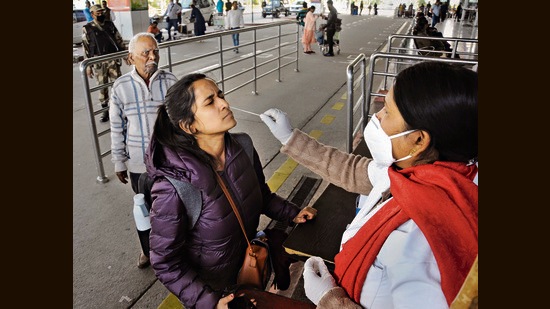Focus on surveillance, govt tells states as it steps up Covid vigil
Union health minister Mansukh Mandaviya said focus should be given to health facility-based sentinel surveillance; pan-respiratory virus surveillance; and community-based surveillance.
New Delhi: The Union government has asked all states to strengthen hospital-based respiratory virus surveillance for early detection of signs of a possible surge from anywhere in the country even as Covid-19 cases rise globally, people familiar with the matter said on Sunday.

“That is a red flag for us if there is a rise in hospitalisation related to Covid-19 or sudden spurt in respiratory illnesses in some areas of country, which is why all hospitals should keep a close watch and identify any unusual pattern,” said a senior health ministry official, requesting anonymity.
In his review meeting with state health ministers on public health preparedness for management of Covid-19 and vaccination progress onFriday, Union health minister Mansukh Mandaviya said focus should be given to health facility-based sentinel surveillance; pan-respiratory virus surveillance; and community-based surveillance.
He further said emphasis should also be given to sewage and wastewater surveillance in various states as humans also shed the virus through their feces.
Also read: In China, couple’s makeshift ‘shield’ against Covid-19 outbreak is viral: Watch
“This is also one of the early signs of spread of the disease within the community if the viral load is high in the sewage system,” said the official cited above. “Sewage sample testing has also been one of the pillars of polio surveillance in the past.”
A nationwide network of sentinel facilities has been made functional to monitor influenza-like-illness (ILI) and severe acute respiratory infections (SARI) for the purpose of community surveillance.
“We have seen so far that around 25-30% of the SARI/ILI cases return positive for Covid if they are tested for the disease, which is why it is important to screen these cases, especially in this weather when flu cases are anyway on the rise,” added the official.
Preventing clustering through strict monitoring of SARI and ILI cases has always been the government strategy as part of its initial efforts to track an unusual jump in cases in certain pockets, and stop further spread of infection.
Initially, random testing was done among SARI and ILI patients in each district of the country to gauge disease prevalence.
Tracking SARI and ILI cases is one of the key surveillance measures also proposed by epidemiologists to determine the disease spread because of similarity of symptoms. The government has established close to 300 sentinel sites and a network of about 60 laboratories that do advanced testing.
“There have hardly been hopsitalisations due to Covid for the past few months and even as the numbers are rising globally, India does not seem to be reporting any unusual surge so far,” said Dr Rommel Tickoo, director, internal medicine department, Max Healthcare. “To me, there might be reported a spurt here or there in future, but (it) looks like India will not see a major wave unless there is some totally different new variant that gets reported.”
The health minister also urged states to strengthen the surveillance system for whole genome sequencing of positive case samples to track the variants through Indian SARS-CoV-2 Genomics Consortium (INSACOG) network to ensure timely detection of newer variants, if any, circulating in the country.
“INSACOG has been regularly performing whole genome sequencing of Covid positive samples even though the share of RT-PCR test—which is required for genome sequencing— had dropped considerably because a majority (of people) is performing Covid test at home using the rapid test kits,” said a senior member of INSACOG, requesting anonymity.
Also read: After cities, China’s rural population at severe Covid-19 risk
Hospitals will be required to submit data to the government through integrated disease surveillance programme that monitors disease outbreaks in the country.
The government data released on Sunday showed India’s active case load stood at 3,424 with 0.18% daily positivity rate and 0.14% weekly positivity rate; active cases at 0.01%; recovery rate at 98.8%; and 227 new cases recorded in the past 24 hours.
“There is no need to panic as of now; however, the government is keeping a close watch on a daily basis and will act according to the evidence presented before it,” said a central government official, requesting anonymity. “The Prime Minister and Union health minister have recently held review meetings with all states, Union territories and top experts in the field of medicines and science. People must rest assured that we are fully prepared to deal with any eventuality.”






